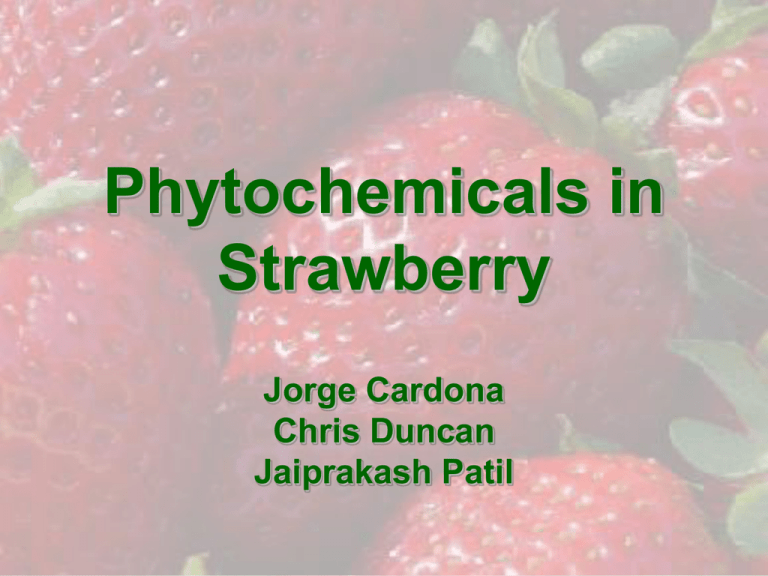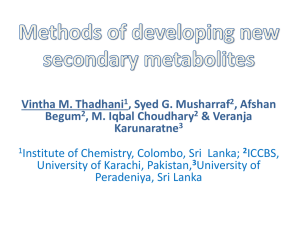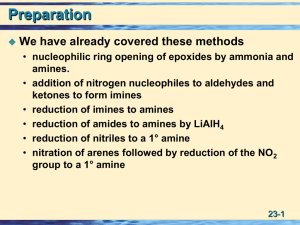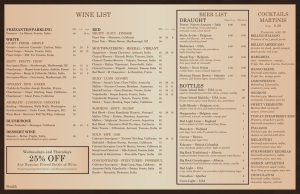Phytochemicals in Strawberry
advertisement

Phytochemicals in Strawberry Jorge Cardona Chris Duncan Jaiprakash Patil Outline Introduction Mechanisms Phytochemical profile Health Benefits Introduction Strawberry is an accessory fruit Strawberries belong to the Rosaceae family Perennial herb stimulated by winter weather Introduction U.S. is the main strawberry producer in the world California and Florida (main productive regions) U.S., Spain, Korea, Japan and Mexico (USDA 2005) Introduction Country Production (1000 tonnes) Egypt 100.0 Germany 146.5 Italy 146.8 Japan 196.2 Korea 202.0 Mexico 128.9 Morocco 118.6 Poland 184.6 Russia 217.0 Spain 308.0 Turkey 200.0 United States 1,053.2 Table 1. World’s main strawberry production countries (FAO statistics 2005). Mechanisms • Antioxidant Capacity Scavenging of reactive oxygen species (ROS) by flavonoids (Pietta 2000) Mechanisms • Metal Chelation – Entrapment of metals – Two or more binding sites – Catechol and galloyl moieties OH OH OH HO OH Binding sites for trace metals (Pietta 2000) Phytochemicals • Phenolic Acids HO COOH – Phenylpropanoids – Aromatic secondary metabolites p-coumaric acid COOH benzoic acid – Substitution with carboxyl or hydroxyl groups generate a bundle of compounds COOH transcinnamic acid Phytochemicals • Ellagic Acid and derivatives EA-4arabinoside EA-4acetylarabinoside EA-4acetylxyloside Ellagic acid glycosides (left), Ellagitannin (right) Sanguiin H-6 (Mullen and others 2003; Lei 2002) Phytochemicals • Ellagic Acid and derivatives HO OH OH OH O HO HO CO O HO CO CO HO OH OH OH CO HO O HO O HO HO HHDP Formation of ellagic acid (Shi and others 2005) HO Ellagic acid Phytochemicals • Carotenoids – Lipid soluble compounds – Present in most plants – Red to yellow colors CH3 H3 C CH3 HO H3C CH3 CH3 CH3 CH3 CH3 CH3 Beta-carotene CH3 H3 C OH CH3 Lutein CH3 CH3 CH3 H3 C CH3 CH3 CH3 Phytochemicals • Omega 3 fatty acids – Fatty acids with three or more double bonds – ALA, EPA, DHA – Important to human health (cell signaling, membrane fluidity) H3C COOH Alpha-linolenic acid (ALA) Phytochemicals • Vitamin C HO – Ascorbic acid O O HO Water soluble vitamin Potent antioxidant Essential in biological functions HO – Important content of Vitamin C in strawberry OH Phytochemicals • Vitamin C comparison Fruit Fiber (g) Potassium Vitamin C (mg) (mg) Sugar (g) Strawberries 3 210 84 7 Apples 4 150 7 14 Grapes 1 266 6 22 Bananas 4 504 13 17 Oranges 3 252 74 13 Phytochemicals • Vitamin C – Recommended intake 90 mg/day (male) 75 mg/day (female) – Content in 147g of strawberry (8 medium strawberries) 96mg of Vitamin C Phytochemicals • Flavonols OH – The flavonols present in strawberries are: OH O HO Quercetin-rutinoside (Rutin) Quercetin-glucoside Quercetinglucuronide Kaempferol-glucuronide OH OH O Quercetin OH O HO OH OH O Kaempferol (Seeram and others 2006) Phytochemicals • Anthocyanins – Flavonoids • Flavan-3-ol – water-soluble pigments – brightly colored • Strawberry • Blueberry • Grape R1 3' R2 4' + R7 O 5' 7 R6 6 5 R3 3 R4 R5 (Seeram and others 2006) Phytochemicals + O HO A • Anthocyanins OH B C OH OH – The major anthocyanins are glycosylated • Pelargonidin 3-glucoside is predominant – 83% of total anthocyanins on average • Pelargonidin 3-rutinoside (8%) • Cyanidin 3-glucoside (7%) (Seeram and others 2006) Phytochemicals • Structures of pigments found in strawberry Anthocyanin aglycones 5-carboxypyranopelargonidin 3-glucoside anthocyanin-flavanol condensed pigments (Andersen and others 2004) Phytochemicals • What makes flavonoids good antioxidant? – Structural arrangement of chemical bonds • Hydroxy groups on phenolic rings • Specific Oxygen Bonds • Specific double bonds OH OH HO O OH OH O Phytochemicals • The Power of Anthocyanins… • The “French Paradox” Phytochemicals • Phytochemical summary Phytochemical Concentration (Fresh fruit) Reference Phenolic Acids 85 mg/kg Aaby and others 2007 Total Ellagic Acid 293 mg/kg Aaby and others 2007 Carotenoids 260 μg/kg Marinova and Ribarova 2007 ω-3 Fatty Acids 292 mg/kg Couture and others 1988 Vitamin C 1041 mg/kg Koplotek and others 2005 Flavonols 13 mg/kg Aaby and others 2007 5256 mg/kg Aaby and others 2007 Anthocyanins Health Benefits • Inhibition of H2O2 induced VEGF Vascular Endothelial Growth Factor Bagchi & others, 2004 Health Benefits • Anti-angiogenic Activity New blood vessel formation Bagchi & others, 2004 Health Benefits • Bioactivity Index • Realties antioxidant activity and antiproliferative activity Sun & others, 2002 Health Benefits • Effect of Anthocyanins on Lung Hemorrhage Rossi & others, 2003 Health Benefits • H2O2 Induced Cytotoxicity Heo & Lee, 2005 Health Benefits • H2O2 Induced Membrane Damage Heo & Lee, 2005 Health Benefits • Strawberry Antiproliferative Activity Meyers & others, 2003 Health Benefits • Anti-proliferative Activity of Fruits Sun & others, 2002 Health Benefits • Inhibition of Proliferation of Colon Cancer Cells Seeram & others, 2006 Health Benefits • Inhibition of Proliferation of Prostate & Breast Cancer Cells Prostate cancer cells Seeram & others, 2006 Breast cancer cells Health Benefits • Inhibition of Proliferation of Prostate & Breast Cancer Cells Seeram & others, 2006 Health Benefits • Cervical & Breast Cancer Inhibition Törrönen & Määttä, 2002 Other Health Benefits • Platelet function & cardiovascular health1 • Platelet activation reduced • Oxidative stress & aging2 • Strawberry retards the affects oxidative stress • age-related neurodegenerative diseases?? • Esophageal & colon cancer3 • Positive correlation with consumption of freeze dried berries 1 Rechner & Kroner, 2005 2 Joseph & others, 2000 3 Stoner & others, 2007 Conclusion • The main compounds in strawberry – – – – Anthocyanins Ellagitannins Phenolic Acids Vitamin C • These contribute to a significant AOX • Numerous Studies on Health Benefits – Cancer Questions? References • • • • • • • • • Bagchi D, Sen CK, Bagchi M, Atalay M. 2004. Anti-angiogenic, Antioxidant, and Anticarcinogenic Properties of a Novel Anthocyanin-Rich Berry Extact Formula. Biochemistry (Moscow) 69(1):75-80. Meyers KJ, Watkins CB, Pritts, MP, Liu RH. 2003. Antioxidant and Antiproliferative Activities of Strawberries. J Agric Food Chem 51:6887-92. Sun J, Chu Y-F, Wu X, Liu RH. 2002. Antioxidant and Antiproliferative Activities of Common Fruits. J Agric Food Chem 50:7449-54. Seeram NP, Lee R, Scheuller HS, Heber D. 2006. Identification of phenolic compounds in strawberries by liquid chromatography electrospray ionization mass spectroscopy. Food Chem 97:1-11. Rossi A, Serraino I, Dugo P, Di Paola R, Mondelo L, Genovese T, Morabito D, Dugo G, Sautebin L, Caputi AP, Cuzzocrea S. 2003. Protective Effect of Anthocyanins from Blackberry in rat Model of Acute Lung Inflammation. Free Radical Research. 37(8):891-900. Heo JH, Lee CY. 2005. Strawberry and Its Anthocyanins Reduce Oxidative Stress-Induced Apoptosis in PC12 Cells. J Agric Food Chem 53:1984-9. Törrönen R, Määttä K. 2002. Bioactive substances and health benefits of strawberries. Acta Horticulturae 567:797-801. Stoner GD, Wang L-S, Zikri N, Chen T, Hecht SS, Huang C, Sardo C, Lechner JF. 2007. Cancer prevention with freeze-dried berries and berry components. Cancer Biology 17:403-10. Joseph JA, Denisova NA, Bielinski D, Fisher DR, Shukitt-Hale B. 2000. Oxidative stress protection and vulnerability in aging: putative nutritional implications for intervention. Mechanisms of Ageing and Development 116:141-153. References • • • • • • • • • • • • Rechner AR, Kroner C. 2005. Anthocyanins and colonic metabolites of dietary polyphenols inhibit platelet function. Thrombosis Research. 116:327-34. USDA. 2005. Fruit and tree nuts outlook. Economic Research Service. US Department of Agriculture FAO 2005. World strawberry production. FAO statistics (online). Available at: http://faostat.fao.org/ Pietta PG. 2000. Flavonoids as antioxidants. J Nat Prod 63:1035-42 Lei Z. 2002. Monomeric ellagitannins in oaks and sweetgum. Dissertation. Virginia Polytechnic Institute and State University Mullen W, Yokota T, Lean ME, Crozier A. 2003. Analysis of ellagitannins and conjugates of ellagic acid and quercetin in raspberry fruits by LC-MSn. Phytochemistry 64:617-24 Shi B, He Q, Yao K, Huang W, Li Q. 2005. Production of ellagic acid from degradation of valonea tannins by Aspergillus niger and Candida utilis. J Chem Technol Biotechnol 80:1154-9 Seeram NP, Lee R, Scheuller HS, Heber D. 2006. Identification of phenolic compounds in strawberries by liquid chromatography electrospray ionization mass spectroscopy. Food Chem 97:1-11 Marinova D, Ribarova F. 2007. HPLC determination of carotenoids in Bulgarian berries. J Food Comp Ana 20:370-4 Aaby K, Wrolstad RE, Ekeberg D, Skrede G. 2007. Polyphenol composition and antioxidant capacity in strawberry purees; Impact of achene level and storage. J Agric Food Chem 55:5156-66 Klopotek Y, Otto K, Bohm V. 2005. Processing strawberries to different products alters contents of vitamin C, total phenolics, total anthocyanins and antioxidant capacity. J Agric Food Chem 53:5640-6 Courture R, Willemot C, Avezard C, Castaigne F, Gosselin A. 1988. Improved extraction of lipids from strawberry. Phytochem 27(7):2033-6



